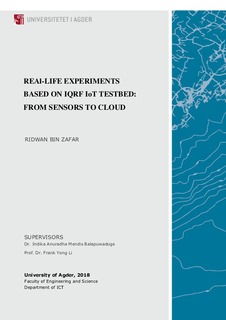| dc.description.abstract | Internet of things (IoT) is the next generation internet technology which connects devices and objects intelligently to control data collected by diverse types of sensors, radio frequency identification and other physical objects. To address the challenges in IoT such as integrating artificial intelligent techniques with IoT concept, developing green IoT technologies and combining IoT and cloud computing, various platforms which support reliable and low power wireless connectivity are required.
IQRF is a recently developed platform for wireless connectivity. It provides low power, low speed, reliable and easy to use wireless connectivity in sub-GHz bands for telemetry and industrial control and building automation. The applications are used for scientific knowledge in practical purposes, especially in industrial usage. It is extensively non-identical from what we are accustomed to nowadays. It has been designed to use IQMESH technology. The purpose for IQMESH is to ensure wireless connectivity wherever it is necessary, covering tens of hundreds of meters up to several kilometers.
In this master’s thesis, we implemented an IQRF platform-based testbed for IoT related application scenarios which can measure various environmental conditions and perform required communications. The research work of this thesis is carried out in three directions, i.e., single-hop and multi-hop communication for temperature measurements, light intensity measurements via integrated light dependent resistors and cloud-based connectivity for IQRF sensors.
The work performed in this thesis provides a valuable result because IQRF does not only solve problems regarding wireless technology, but it also supports industrial control, remote control and cloud control as well. Also, as the devices come with different input/output pins, they are easily maneuverable to connect different external sensors to get accurate results. In this thesis, the employed research methods, experiments, readings and related discussions have been presented accordingly.
Key words: IQRF, IoT, Wireless Sensor Network, Light Dependent Resistor, GSM Gateway, IEEE 802.15.4, IQRF Cloud | nb_NO |

